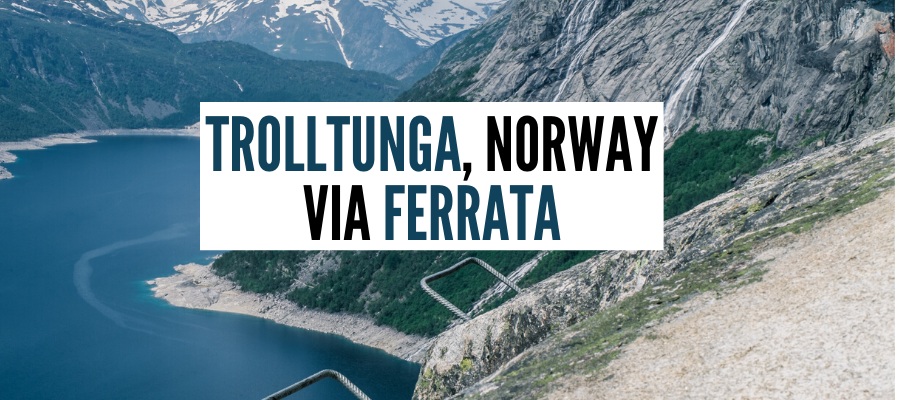Trolltunga via Ferrata – Adventurous alternative to the famous Trolltunga hike in Norway
Trolltunga, the iconic rock in Norway is known for its stunning views, long trail, and well, tourists. The popularity of the Trolltunga hike makes the trail busy, especially in the high season. Luckily, there is another way of hiking Trolltunga and admiring the views – by climbing the wall of Trolltunga via Ferrata. And you don’t even have to have any climbing experience! It’s an adventurous off-the-beaten way of getting to the famous rock and so much fun. Check out how you can climb Trolltunga via Ferrata yourself.

Trolltunga (“Troll Tounge”), the most spectacular formation in Norway is a flat rock sticking out of the edge of the mountain cliff, like a tongue. Positioned at 1,100 meters above sea level and hovering 700 meters over the Ringedalsvatnet lake, at the western edge of the Hardangervidda plateau, it provides magnificent views of the area around. Trolltunga hike is one of the best hikes in Norway, which makes it no surprise that it’s visited annually by 80,000 people.
Hiking Trolltunga was on my list since I moved to Oslo three years ago. However, the increasing popularity of the hike was putting me off a little bit. You know, I am not a fan of crowds in general, and crowds in the mountains are something that I have nightmares about. Why go somewhere and wait in the queue for 2 hours (yes, really), when Norway has so many other amazing hikes and views? But there are places that are so special, and that everyone talks about that you want to also see for yourself. The Trolltunga charm was haunting me and I decided to finally climb it.
But before that, I was looking for ways of avoiding the masses of tourists flocking to the trail. There are ways to avoid crowds, even in the most popular locations, like Kjerag hike, the one with the stone hanging above the fjord. I knew I need to find a way for Trolltunga.

Trolltunga Via Ferrata and Trolltunga Hike
The hike to Trolltunga is long and demanding (but worth what you get at the end!).
From the main parking P2 in Skjeggedal, the round trip is 28 km with an ascent of 800 meters. The hike usually takes between 8-12 hours in both ways. If you start from the car park P2, like most people, the first part of the journey would lead you through the windy asphalt 3-kilometer long road.
To avoid the unpleasant asphalt walk and shorten the hike, you can start from the top car park at P3 Mågelitopp. The hike from there takes a 20 km round trip and around 7-10 hours with 300 meters ascent. Unfortunately, the top car park is very small and only has space for 30 cars. Alternatively, you can take a bus there, but this adds to the whole cost of the trip (which is not cheap, considering the car park charges).
This trail is very popular with people and you can see groups going in each direction every day in the summer. You go up one way and come down exactly the same way. After the initial steep climb, it follows the plateau, which is nice, but it can get a bit boring after a while until you reach the lake viewpoint.
However, if you want to make things a bit more interesting, you have one more option for climbing Trolltunga – the Trolltunga via Ferrata. From the Ferrata, you first walk by the lake on a nice flat and shaded path, and then you climb up the wall, from where you have a constant stunning view of the Ringedalsvatnet lake. You can take a normal trail back to the car park.



Trolltunga via Ferrata
Via Ferrata in Italian means “iron path”. It is a protected climbing route, typically with metal ladders, grips, and wires. In 2005, the new via Ferrata to Trolltunga has been open. Now, instead of taking the same hiking route up and down, you can awaken your adventurous self and scale the steep face of the mountain to get to Trolltunga.
The route is not difficult (graded between B/C), and consists mainly of the metal steps hanging on the wall. There are plenty of places to stop and rest and admire the view below. And a good part? You don’t need any special climbing experience or knowledge. When you go with a guide, everything will be taken care of. If you’ve already done some via Ferratas before, you can try to do this one on your own.
We took around 2 hours to climb it, with a very relaxed pace, a lot of breaks, and waiting for the organized group in front of us to pass. In nice weather, it gets quite hot on the wall, so bring plenty of water.
We were climbing end of June and the hiking trail was still covered partially in snow, but there was no snow on the via Ferrata.



'My travel abroad. > Norway tracking(2023.Jul)' 카테고리의 다른 글
| 7-2 베르겐(Bergen)으로 가는 길 (0) | 2023.08.08 |
|---|---|
| 7-1 Odda의 마지막 선물 (0) | 2023.08.08 |
| 6-4 Trolltunga아래 호수를 보면서 하산 (0) | 2023.08.07 |
| 트롤(Troll) (0) | 2023.08.07 |
| 6-3 가장 아름다운암석 트롤퉁가 (0) | 2023.08.07 |